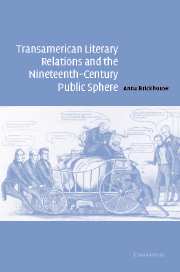Book contents
- Frontmatter
- Contents
- Acknowledgments
- Note on texts and translations
- Prologue
- 1 Introduction: transamerican renaissance
- 2 Scattered traditions: the transamerican genealogies of Jicoténcal
- 3 A francophone view of comparative American literature: Revue des Colonies and the translations of abolition
- 4 Cuban stories
- 5 Hawthorne's Mexican genealogies
- 6 Transamerican theatre: Pierre Faubert and L'Oncle Tom
- Epilogue
- Notes
- Index
6 - Transamerican theatre: Pierre Faubert and L'Oncle Tom
Published online by Cambridge University Press: 22 September 2009
- Frontmatter
- Contents
- Acknowledgments
- Note on texts and translations
- Prologue
- 1 Introduction: transamerican renaissance
- 2 Scattered traditions: the transamerican genealogies of Jicoténcal
- 3 A francophone view of comparative American literature: Revue des Colonies and the translations of abolition
- 4 Cuban stories
- 5 Hawthorne's Mexican genealogies
- 6 Transamerican theatre: Pierre Faubert and L'Oncle Tom
- Epilogue
- Notes
- Index
Summary
IMPASSE AND IMAGINATION: HAITI IN THE US PUBLIC SPHERE
In September 1855, at the height of the expansionist presidential administration that Hawthorne had helped to usher into Washington with his popular biography of Pierce, Putnam's Monthly Magazine of American Science, Literature, and Art featured a long quasi-anthropological article titled “The Amazons of South America.” Though published anonymously and treating a rather arcane subject, the article implicates the Mexican genealogy treated in the previous chapter within the historical sources recording the legend of Amazons in the Americas. Printed alongside a review of Leaves of Grass that approvingly cites Whitman's commemoration of “the fall of Alamo” during the US-Mexican War, the essay gives us a glimpse of the varied kinds of hemispheric imaginings that this era's many generalist periodicals were circulating in the US public sphere. Synthesizing a number of writings in Spanish and English, the article proposed a Mexican-Caribbean continuum of history and legend that ostensibly “solved” the mysterious questions surrounding these indigenous female warriors by positing the Amazons as the lineal descendants and worshippers of the feathered-serpent god known as Quetzalcoatl, the mythical-historical deity and king who first appeared in the time of the Toltecs. Like the figure discussed at the end of the previous chapter – Coatlalopeuh, or “She who has dominion over serpents” – Quetzalcoatl was descended from the early Mesoamerican goddess Coatlicue, or Serpent Skirt, and retained the goddess's ancient identification with snakes.
- Type
- Chapter
- Information
- Publisher: Cambridge University PressPrint publication year: 2004
- 4
- Cited by

